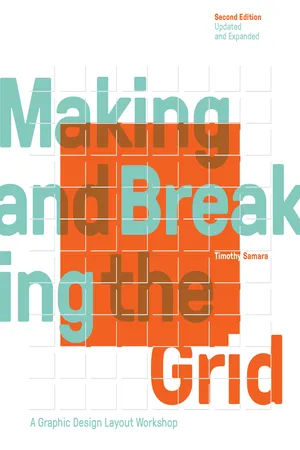1 Making the Grid
All design work involves problem solving on both visual and organizational levels. Pictures and symbols, fields of text, headlines, tabular data: all these pieces must come together to communicate as a totality. A grid is one approach to doing so.
Before anything else, a grid introduces systematic order to a layout. Not only does it distinguish different types of information, easing a user’s navigation through them but—just as importantly—it ensures vital cohesion among visual elements, harmonizing them through the systems of spatial proportions and positioning logic it defines.
Using a grid permits a designer to more rapidly lay out enormous amounts of information because many design considerations are addressed in building the grid’s structure at the outset of a project. A grid also allows many individuals to collaborate on the same project, or on related projects, without compromising established visual qualities from one instance to the next. The benefits of working with a grid are simple: clarity, efficiency, and continuity.
To some designers, the grid is an inherent part of the craft of designing, as is joinery in the craft of furniture making. Its assimilation into practice has been part of an evolution in how graphic designers think about designing, as well as a response to specific communication and production issues needing to be addressed at various times throughout the discipline’s history.
Coming to Order—
A Brief History of the Grid in Graphic Design
The grid’s development over the past 150 years coincides with dramatic technological and social changes in Western civilization and the response of philosophers, artists, and designers to those changes. The Industrial Revolution that began in 1740s England changed the way people lived—its effect on our culture was fundamental. As the invention of mechanical power induced people to seek a living in cities, power shifted away from the land-owning aristocracy toward manufacturers, merchants, and the working class. Demand from an urban population with ever-increasing buying power stimulated technology, fueling mass production, lowered costs, and increased availability.
___ Design assumed an important role in communicating the desirability of material goods. In addition, the French and American revolutions facilitated progress in social equality, public education, and literacy, and helped to create a greater audience for reading material.
___ With this enormous psychographic change came aesthetic confusion. The Beaux-Arts tradition, much unchanged since the Renaissance and bolstered by the strong moral and spiritual convictions of the times, held on to its aesthetic contrivances and notions of neoclassical taste. A Victorian penchant for Gothic architecture merged oddly with a taste for exotic textures imported from the outreaches of the British Empire.
___ Contradictory design approaches and the need to supply the consuming masses with products reached a kind of plateau in 1856 when writer and designer Owen Jones produced The Grammar of Ornament, an enormous catalog of patterns, styles, and embellishments that were co-opted to mass-produce poorly made goods of questionable aesthetic quality.
FITNESS OF PURPOSE
The English Arts and Crafts movement in architecture, painting, and design grew out of a reaction to this decline. At the movement’s forefront was William Morris, a young student of privileged background who had become interested in poetry and architecture—and their seeming disconnection with the industrialized world. Morris was inspired by John Ruskin, a writer who insisted art could be the basis of a social order that improved lives by unifying it with labor, as it had in the Middle Ages. Together with Edward Burne-Jones, a fellow poet and painter, and Philip Webb, an architect, Morris undertook the revitalization of England’s daily aesthetic life. Webb’s design of Red House in 1860 for a just-married Morris organized the spaces asymmetrically, based on their intended uses, thereby dictating the shape of the facade. At the time, this idea was unheard of—the prevailing neoclassical model called for a box layout with a symmetrical facade.
___ Furthermore, no suitable furnishings existed for such a house. Morris was compelled to design and supervise the production of all its furniture, textiles, glass, and objects, becoming a master craftsman in the process. The company that resulted from this experience, Morris and Company, vigorously advocated the notion that fitness of purpose inspired form; their prolific output in textiles, objects, glass, and furnishings heralded a way of working that responded to content, was socially concerned, and paid utmost attention to the finished quality of the work, even wh...
